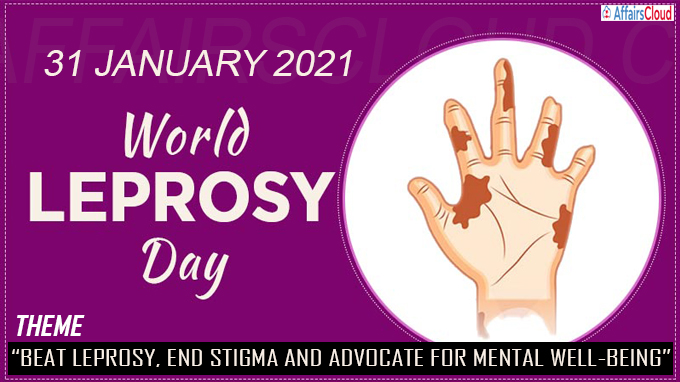 World Leprosy Day is annually observed across the globe on the last Sunday of January to create awareness about leprosy, also known as Hansen’s Disease. This day is a celebration of the leprosy community to advocate the rights of the person affected with the Leprosy and to create awareness about the medical and social implications of leprosy.
World Leprosy Day is annually observed across the globe on the last Sunday of January to create awareness about leprosy, also known as Hansen’s Disease. This day is a celebration of the leprosy community to advocate the rights of the person affected with the Leprosy and to create awareness about the medical and social implications of leprosy.
The World Leprosy Day 2021 falls on 31st January 2021.
The theme of the 2021 World Leprosy day is “Beat Leprosy, End Stigma and Advocate for Mental Well-Being”.
- The World Leprosy Day 2020 was celebrated on 26th January 2020
- The World Leprosy Day 2022 will be observed on 30th January 2022
Annually, India celebrates the World Leprosy day on 30th January, the death anniversary of Mahatma Gandhi.
Background:
i.The World Leprosy Day was established by Raoul Follereau, French philanthropist and writer, in 1954.
ii.The day aims to invite the international community to spread awareness that Leprosy is curable and to join the movement to end stigma and advocate for the mental wellbeing of leprosy patients and other neglected tropical diseases.
Events 2020:
i.As a part of the World Leprosy Day 2021, the 16th Global Appeal to End Stigma and Discrimination against Persons Affected by Leprosy was launched during an online ceremony.
ii.It was organised by the Sasakawa Leprosy (Hansen’s Disease) Initiative and the appeal was endorsed by the International Trade Union Confederation(ITUC) under the theme “Right To Work”.
Sasakawa Leprosy (Hansen’s Disease) Initiative:
The Sasakawa Leprosy (Hansen’s Disease) Initiative is a strategic alliance between World Health Organization (WHO) Goodwill Ambassador for Leprosy Elimination Yohei Sasakawa, The Nippon Foundation and Sasakawa Health Foundation to achieve a world without leprosy.
Leprosy and India:
i.According to WHO, India has the highest number of new cases of leprosy per annum followed by Brazil and Indonesia.
ii.India has not been able to eradicate (zero new cases) leprosy despite having it on the national target.
National Leprosy Eradication Programme (NLEP):
i.The government of India initiated the leprosy control programme in 1955 which was revised as National Leprosy Eradication Programme (NLEP) in 1983 following the introduction of Multi Drug Therapy(MDT) in 1982.
ii.As of March 2018, 29 states/ Union Territory has achieved the level of leprosy elimination, prevalence rate of less than 1 case per 10000 populations.
iii.Around 572 districts out of 705 districts (81.13%) have achieved elimination level.
Leprosy:
i.Leprosy is a chronic infectious disease caused by Mycobacterium leprae.
ii.The disease affects the skin, peripheral nerves, mucosal surface of the upper respiratory tract and eyes.
Transmission:
Leprosy is transmitted through droplets from nose and mouth during close and frequent contact with untreated patients.
Treatment:
i.Leprosy is curable with a combination of drugs known as MDT.
ii.The combination of drugs used in MDT are based on the classification of the disease.




